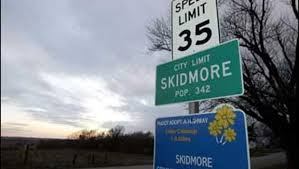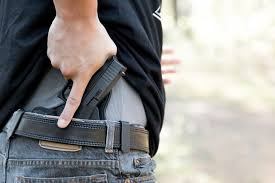
Today’s media will be carrying the story about NRA Board member and NASCAR team owner Dick Childress, who evidently frightened away three dopes who broke into his home by firing a gun at them, an event which Childress claims resulted in no loss of life to himself or his wife thanks to “the 2nd Amendment and God.” No doubt this story will be repeated when the Senate takes up a debate on the national concealed-carry reciprocity bill, with Childress becoming a poster-boy for the idea that we should all be going around armed.
If there is one cottage industry which has emerged and grown within the gun violence prevention (GVP) research community, it’s the continued effort to debunk the work of John Lott, whose book - More Guns Less Crime - has been the clarion-call for the concealed-carry (CCW) movement since it was first published in 1998. The book first appeared when the residents of nearly half the states still had to prove a need to walk around with a gun. As of today, only 8 states still give the authorities who issue CCW some discretion as to who shall and shall not be able to walk around armed; the rest of the country couldn’t care less.
Lott’s argument is based on statistical models which show that as the number of concealed-carry licenses increase in most jurisdictions, criminal activity shifts from in-person to anonymous crime; i.e., a decline in homicides but an increase in burglaries, his argument based on the assumption that criminals don’t want to confront potential crime victims who might be armed.
Lott’s thesis has been attacked by any number of GVP researchers, of whom perhaps the most prominent and prolific scholar is a law professor at Stanford, John Donohue, who has published two, very detailed critiques of Lott’s work. The first paper was published in 2012, and basically argued that Lott’s argument was based on data which was, at best, incomplete. The second paper was released this year, and went further because it claimed that by using a more sophisticated modeling approach, the data actually showed that in CCW states that violent crime went up. Lott has replied in detail to both these critiques, so the battle wages on.
I recently began a study of murder from a forensic point of view, hence, I took the trouble to read Lott and Donohue again and find myself unable to subscribe to either point of view. The reason I am unpersuaded has nothing to do with the validity of statistical models employed in either approaches; rather, it is based on the assumptions that both Lott and Donohue make about the behavior of criminals versus the behavior of armed citizens, assumptions which I believe in both cases to be totally wrong.
Let’s go back to the three jerks who broke into the home where Dick Childress and his wife were asleep. Obviously, they didn’t do their homework in preparation for the attack because not only were the residents in their home, but the homeowner was certainly armed. I mean, a member of the NRA Board wouldn’t have been able to pull out a gun?
But let’s presume for the sake of argument that the burglary team’s collective IQ wasn’t below the standard of ‘dumb.’ The point is that anonymous crimes, crimes of stealth, usually involve some degree of thought and planning before the crime occurs. On the other hand, what emerges from the brilliant, 1,000-page textbook on forensic homicide by Lester Adelson is the proven argument that of all crimes, murder is the one crime which is preceded by any planning or conscious thought at all.
Then there’s the question of the degree to which the population which commits the most violent crime - murder - has any degree of contact with the population that believes they need to protect themselves by walking around armed. Because if these two population groups don’t come into contact with one another, making some kind of causal connection between how the two groups behave regarding any issue is about as far away from reality as you can get.
Violent crime, particularly murder, is overwhelmingly an intra-racial affair. Blacks kill blacks, whites kill whites; for both races the intra-racial character is around 90 percent. And just as murder is segregated by race, it’s also segregated by income and where people live. Warren Buffet lives in Omaha, the only murder in Buffet’s neighborhood in the last couple of years was an elderly lady, living alone, who met some dope on the internet and then invited him to move in. He repaid her for her generosity and kindness by bopping her over the head and running off with her jewels. Meanwhile, a mile away from Buffet’s house is a small ghetto surrounding a ballfield and some swing sets known as Giffords Park. The neighborhood has about 5,000 residents but chalks up 8 or 9 shootings each year, the reason that most of the victims survive is because the park is located a block away from the Creighton University Medical Center and ER.
If we are really going to do something about the behavior caused by guns which will probably result in more than 12,000 murders this year, I think it’s time to stop indulging in arguments about statistics and statistical models and start paying attention to how, when and where these murders actually occur. And by the way, don’t make the mistake of assuming that the number of individuals who have concealed-carry licenses represents in any way, shape or form, how many Americans are walking around with guns. Let me break it to you gently - in neighborhoods, both white and black, where most murders occur, everybody’s got a gun.
Have A Wonderful and Joyous Christmas Season.
Like this:
Like Loading...

 This truism then morphs into a second truism, namely, that minorities, particularly African-American adolescents and young men, are disproportionately represented in the numbers killed each year with guns. This latter belief is bandied over the media because every weekend, it seems, Chicago is ablaze with guns, ditto other major urban centers with large minority populations and intractable inner-city poverty like St. Louis, Baltimore and New Orleans.
This truism then morphs into a second truism, namely, that minorities, particularly African-American adolescents and young men, are disproportionately represented in the numbers killed each year with guns. This latter belief is bandied over the media because every weekend, it seems, Chicago is ablaze with guns, ditto other major urban centers with large minority populations and intractable inner-city poverty like St. Louis, Baltimore and New Orleans.
 By now everyone is aware of the ‘fact’ that people with guns prevent millions of crimes from being committed each year. This argument first burst out of the brain of Gary Kleck in the early 90’s, and
By now everyone is aware of the ‘fact’ that people with guns prevent millions of crimes from being committed each year. This argument first burst out of the brain of Gary Kleck in the early 90’s, and